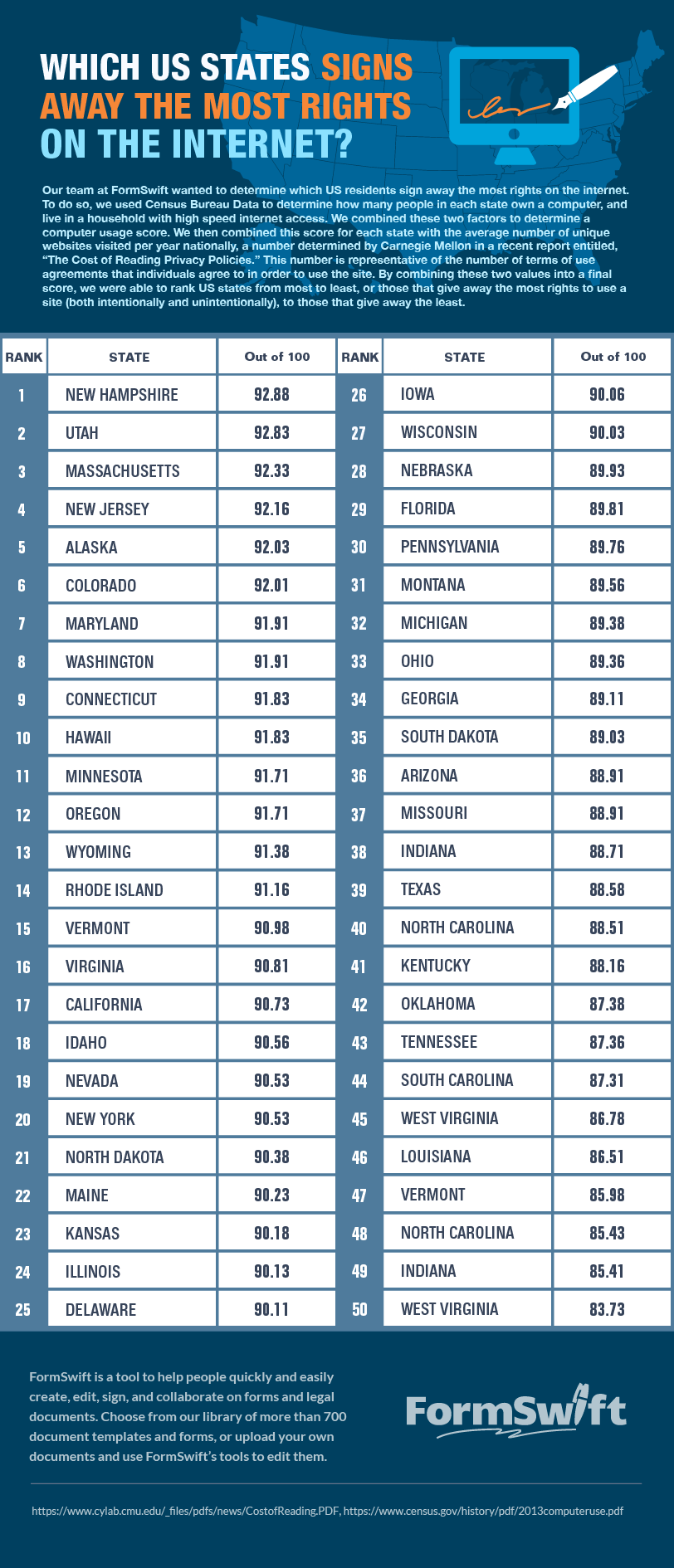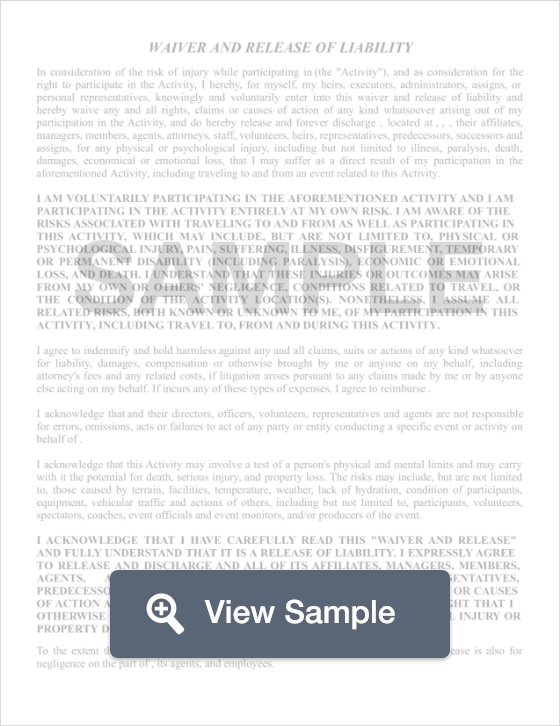What is a Waiver?
A waiver is a document that details a party’s surrender of certain rights. There are many different types of waivers that may be used in a legal setting. Different waivers include liability waivers, damage waivers, or procedural waivers. Waivers are a complex document and they should not be taken lightly. Because a waiver can affect your legal matters, you should consult a lawyer when considering a waiver.
A waiver will typically detail specific terms that an individual is agreeing to. These terms should be clearly stated, and you should understand them completely before signing the waiver. All waivers must be signed and dated to be official. Some waivers may also require you to get a witness or have the document notarized.
Contents of a Waiver
A waiver form, also known as a "release of liability" form, is an important document to have in place if you are doing any of the following:
- Coordinating an event, such as a charity run or pie-eating contest.
- Electing to start a business in which participants face physical risk.
- This can include everything from hot air ballooning to skydiving to modern dance.
Waivers are common in places of employment. Many athletes, such as ball-players, skiers, snowboarders, professional race car drivers, and players of almost any sport you may have heard of, must sign waivers in order to be signed to a team or play for a league. Regardless if someone is playing a sport, or working for a job that poses a risk, it is common for employers to make their employees sign waivers. Even cab drivers are sometimes asked to sign waivers when driving for a cab company, as many possibilities can occur en route to their destination.
Even if you're not ready to start your business or coordinate your event - even if these ideas are just a gleam in your proverbial eye - you can save yourself time by drawing up a waiver template and having it at the ready. There are two ways to go about this - either hire a professional to do it for you (less effort, but expensive and entirely unnecessary) or creating your own waiver. To make the latter option easier, we've broken down the basic components of a waiver below:
Personalization
It's a good idea to open the waiver form with a simple lead-in so that the waiver works as a personalized form letter. For example:
Dear Ms. Agavales,
As per CCS policy, we require that you read and sign the following letter of waiver before making use of the CCS facility.
It's also a good idea to follow your waiver template's terms with a little note, something like:
We at CCS thank you for your cooperation. We hope you enjoy making use of our facilities. Happy spelunking!
Sincerely,
Marcus Brigham Gross.
Capital City Spelunking, Inc.
Statement of Waiver
In other words, there should be some initial text signifying that this is, indeed, a legal document and that the contents affect the signer's legal rights. Titling it "Release of Liability" or "Waiver" is a good start, and printing a warning just below the title is a good way to support the evidence.
Terms
Typically, these are written in the form of "I agree to" statements. Remember, these need to cover ALL your bases, and all of the applicable laws and considerations should be clearly defined. Here are a couple of example sentences:
I hereby agree that Capital City Spelunking (CCS) is not responsible for any accidents that may occur in the Capitalian Cave Chain or other CCS property.
I hereby agree that I may not file a lawsuit against CCS or any of its employees in the event of accident, injury or death.
Here in the United States, where multiple languages are spoken throughout the country, only offering waivers in English would leave English language learners in the dark as to what they are signing or agreeing to. It is wise to offer waivers in English, as well as other commonly spoken languages in your area to ensure all users are fully aware of what they are signing. For example, if you live in an area with a large Latino population, then it is wise to offer your waiver in English and Spanish. If you live in an area with a large anglo-french population, then it is wise to offer your waiver in English and French.
Date and Signature
This is pretty self-explanatory - the recipient of the document must sign and date the form to bring the waiver into effect.
What Rights Do You Give Up When Signing Up For Your Favorite Services?
By FormSwift Editorial Team
June 27, 2018
Introduction
Each of us is bombarded with user agreements--online, on our phones, at the bank, etc. The vast majority of users sign the agreement without reading a word of the fine print. A study by Carnegie Mellon University found that the median length of a privacy policy is over 2500 words, which takes approximately 10 minutes to read. Carnegie Mellon researchers estimate that if an individual read every word of every privacy policy they signed, it would take approximately 25 days each year.
Failing to read user agreements, while ubiquitous, is not without potential risks. Signing a user agreement effectively signs away certain rights. In this guide, we will cover common user agreements and which rights you forfeit in each situation.
Social Media
Users technically “own” all of the content and information they post on Facebook, including photos and videos. According to the company’s terms of service, another user cannot “tag” you in a post without your consent.
Facebook, on the other hand, has the right to keep the content on your profile, even if you delete your account. By signing Facebook’s user agreement, you grant Facebook the license to use your content for an undetermined period of time. Therefore, any content you “share” or post on a friend’s page cannot be deleted, unless all parties involved delete their accounts.
As Facebook’s terms read: “You grant us a non-exclusive, transferable, sub-licensable, royalty-free, worldwide license to use any IP content that you post on or in connection with Facebook.”
Facebook can use your name, pictures and other information for commercial purposes without providing you any compensation.
Facebook’s terms of use can be accessed here: https://www.facebook.com/terms.php
Furthermore, Facebook can suspend your page or remove it entirely if you fail to comply with their terms.
- Terms include using your real name, keeping contact information updated, using Facebook for unlicensed commercial purposes, etc.
Essentially, using a service like Facebook requires voluntary relinquishment of all rights to your content.
Facebook owns Instagram, therefore the user agreements are virtually identical with both sites. Instagram collects all the information you provide and sells it to advertisers. Their privacy terms can be found here: https://help.instagram.com/155833707900388
Twitter obtains “broad” rights to your content. Twitter can sell, change, redistribute, or pass content to partners. Moreover, even if you delete your Twitter account, the rights Twitter grants others (i.e. customers, partners, etc.) to use your content can never be terminated.
Linkedin can copy or make what they term “derivative works” based on user content.
Snapchat
Snapchat reserves the right to “review, screen, and delete your content at any time for any reason.” They can also license your name, voice, etc. to use in the company’s advertising content. Snap, like almost every social media network, is allowed to use the images your post for commercial purposes.
Ridesharing - Lyft, Uber, etc.
For Drivers:
Arbitration clauses are a big legal issue with ride-sharing companies. Companies are increasingly facing legal action challenging the validity of their driver agreements.
- Since 2013, Uber’s agreement prevents drivers from suing the company in court (they instead have to use private arbitration).
- Uber drivers are also prohibited from forming a class action lawsuit.
- Forced work status:
- Uber’s driver agreement establishes driver’s status as “self-employed,” instead of Uber employees. As a result, Uber is not required to pay drivers the minimum living wage.
For Riders:
In March 2017, Uber argued in a US court that riders cannot sue the company, because they signed the user agreement. Therefore, Uber is not liable for anything that happens to you while you are in the car.
- Uber’s terms of use can be found here: https://www.uber.com/legal/terms/us/
Netflix and other show streaming services
The company’s rights:
Users are required to sign an arbitration agreement in their terms of service when signing up for a streaming account. The user agreement limits your rights of use. For example, you cannot use Netflix for “commercial use,” which includes streaming Netflix in a business setting, in waiting rooms or in lobbies, or at a bar, restaurant or medical office.
- Doing so constitutes a breach of contract and may result in you receiving a cease and desist letter.
- You may also be sued for copyright infringement.
Furthermore, Netflix can share what you are watching with their partners.
Their terms of use are here: https://help.netflix.com/en/legal/termsofuse
Bank accounts
When you open a new bank account you must sign a user agreement. That agreement typically includes arbitration clauses, which limits your rights to file class-action lawsuits against the bank.
Typical arbitration clauses include:
- A statement notifying customers that they cannot sue a bank in court.
- Limitations on damages.
Moreover, legal action is often more expensive for the consumer and an arbiter might be more partial to the company, making it harder for the consumer to prevail in a legal action. There has also been a recent outcry against arbitration agreements that limit damages for victims of sexual assault. Many state lawmakers are rethinking the legality of forced arbitration procedures to settle workplace disputes.
The issues involving workers suing employers, despite various waivers, has been a long running argument, especially over the enforceability of arbitration agreements with class action waivers. Interestingly, in May of 2018, the Supreme Court ruled that class action waivers in the employment context do not violate the Nation Labor Regulations Act, and are, in fact, enforceable. In short, a person signing a workplace waiver essentially waives his or her procedural rights.
Though some waivers may require an English dictionary and a lot of Googling to figure out some of the words in a waiver, it's well worth your time.
Gym membership contracts
All members sign a liability waiver as part of their gym membership, whether it's on online waiver or a hard copy. Common agreements state the gym is not responsible for any injury or related damages incurred while using the gym (nevertheless, some gyms will carry an insurance policy to further protect them from liability if they were to be sued for a personal injury or gross negligence). Additionally, small gyms, perhaps personally owned or family owned gyms may neglect to purchase incident insurance due to the high cost. However, a better choice would be to form the small gym as an LLC, so despite a waiver, if a customer sues, he or she cannot come after the owner's personal property.
State law may further limit gym liability. Certain states, for example, do not require gym’s to keep medical equipment for treating serious conditions like a heart attack. Additionally, not all states require gyms to have AEDs (defibrillators).
- Tip: before joining a gym, confirm the gym is prepared for an emergency and that the staff is trained to assist in emergency situations.
Some gyms, moreover, are not required to have a license to train you. Therefore, when you sign a waiver to hire a personal trainer, be sure to verify your trainer’s licenses and qualifications.
Oftentimes, minors will join gyms either as a class requirement or by personal choice. It is important that if a gym member is a minor, a parent or legal guardian must sign the waiver in order for the minor to legally join the gym, and waive the gym from liability.
Lastly, most gym contracts absolve the gym of responsibility for any lost or stolen items, even if they are stolen out of a locked locker
- Tip: it is important to remember that in the event of gross negligence, the liability waiver you sign may be considered null/void. If something egregious occurs, do not simply ignore it because you signed a waiver. Instead, contact a lawyer and discuss your legal options.
Conclusion
Most of us sign user agreements on a near-daily basis. We may not have the time to read through the fine print, but it is important we have a sense of the legal ramifications of our signature. This guide was designed to give you a general sense of what is included in the user agreements we are most likely to encounter.
Which State Signs Away the Most Rights on the Internet?
June 27, 2018

Methodology
Our team at FormSwift wanted to determine which US residents sign away the most rights on the internet. To do so, we used Census Bureau Data to determine how many people in each state own a computer, and live in a household with high speed internet access. We combined these two factors to determine a computer usage score. We then combined this score for each state with the average number of unique websites visited per year nationally, a number determined by Carnegie Mellon in a recent report entitled, “The Cost of Reading Privacy Policies.” This number is representative of the number of terms of use agreements that individuals agree to in order to use the site. By combining these two values into a final score, we were able to rank US states from most to least, or those that give away the most rights to use a site (both intentionally and unintentionally), to those that give away the least.
Download a PDF or Word Template
Waiver
A waiver is used by a business to absolve them from legal liability regarding their products or services. An example of a waiver can be seen at many public parks by a sign that states the city or the owner of the park are not responsible for any injuries that may occur on their property.
 Read More
Read More
Scope of Work
Scope of Work is used by businesses to define the work that should be completed by an employee or contractor in regards to a specified project. Scope of Work will also document any reports or goal reporting that should be completed during the project.
 Read More
Read More
Income Statement
The purpose of an income statement is to give a synopsis of the financial health of a business over a certain length of time. An income statement includes the revenue and the expenses of the business.
 Read More
Read More
Medical Consent
A medical consent form is required if the patient isn't of legal age or mentally competent enough to consent to medical treatment on their own. A medical consent form should be completed by a parent or guardian if the minor is traveling with another person.
 Read More
Read More

